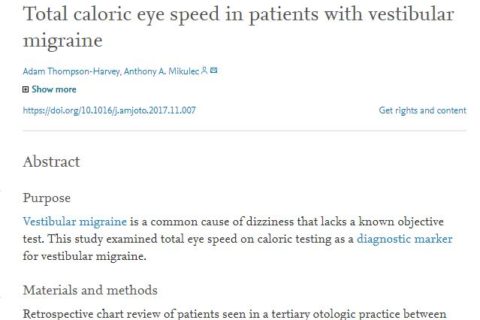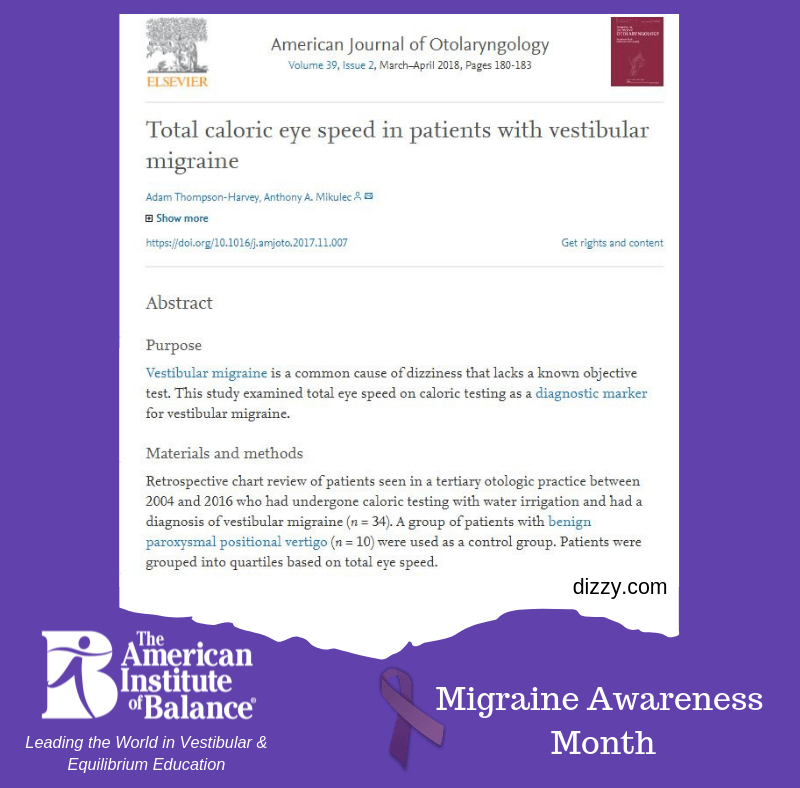
Migraine Awareness – Caloric Eye Speed
Published on: June 4, 2019
 Thompson-Harvey and Mikulec (American Journal of Otolaryngology 39, 180–183 (2018)) investigated the utility of using caloric eye speed to inform the diagnosis of vestibular migraine (VM). Comparisons between from 34 vestibular migraineurs and 10 patients with benign paroxysmal positional vertigo (BPPV) revealed that only the lowest caloric eye speeds were correlated to VM. The measure is not a valid way to distinguish VM from other vestibular disorders.
Thompson-Harvey and Mikulec (American Journal of Otolaryngology 39, 180–183 (2018)) investigated the utility of using caloric eye speed to inform the diagnosis of vestibular migraine (VM). Comparisons between from 34 vestibular migraineurs and 10 patients with benign paroxysmal positional vertigo (BPPV) revealed that only the lowest caloric eye speeds were correlated to VM. The measure is not a valid way to distinguish VM from other vestibular disorders.
Recent Posts
The Efficacy of the Gans Repositioning Maneuver in Comparison with the Epley Maneuver in Elderly Patients with Benign Paroxysmal Positional Vertigo
Published on: June 30, 2025
Published on: 4 March 2025 Auditory and Vestibular Research, Spring 2025;34(2):144-150 Benign Paroxysmal Positional Vertigo (BPPV) impacts the quality of life of affected people, especially the elderly. The Epley maneuver […]
Read more
Seasonal incidence of benign paroxysmal positional vertigo
Published on: February 6, 2025
Journal of Otolaryngology – ENT Research | Volume 16 – Issue 1 – 2025 Benign paroxysmal positional vertigo (BPPV) is the most frequent type of peripheral vestibular vertigo.1 BPPV is […]
Read more
When Positional Vertigo is Not “Benign”
Published on:
Hearingreview.com | January/February 2025 Benign paroxysmal positional vertigo (BPPV) is the No. 1 cause of vertigo. Except when it’s actually not the cause. Vertebral artery (VA) compromise can mimic BPPV […]
Read more
Comparison between Epley and Gans Repositioning Maneuvers for Posterior Canal BPPV: A Randomized Controlled Trial
Published on: March 26, 2024
Annals of Indian Academy of Neurology | Volume 26 – Issue 4 – July-August 2023 Benign paroxysmal positional vertigo (BPPV) is one of the commonly occurring causes of vertigo. BPPV […]
Read more

 Thompson-Harvey and Mikulec (American Journal of Otolaryngology 39, 180–183 (2018)) investigated the utility of using caloric eye speed to inform the diagnosis of vestibular migraine (VM). Comparisons between from 34 vestibular migraineurs and 10 patients with benign paroxysmal positional vertigo (BPPV) revealed that only the lowest caloric eye speeds were correlated to VM. The measure is not a valid way to distinguish VM from other vestibular disorders.
Thompson-Harvey and Mikulec (American Journal of Otolaryngology 39, 180–183 (2018)) investigated the utility of using caloric eye speed to inform the diagnosis of vestibular migraine (VM). Comparisons between from 34 vestibular migraineurs and 10 patients with benign paroxysmal positional vertigo (BPPV) revealed that only the lowest caloric eye speeds were correlated to VM. The measure is not a valid way to distinguish VM from other vestibular disorders.